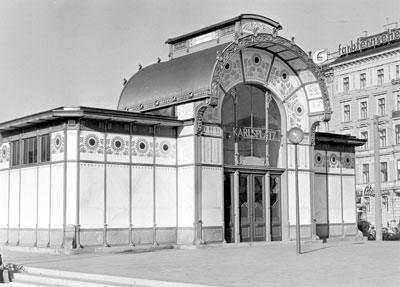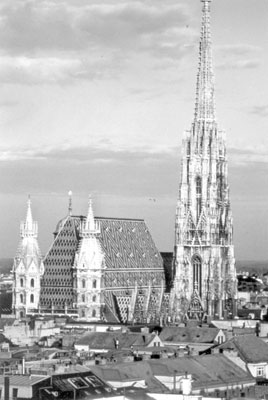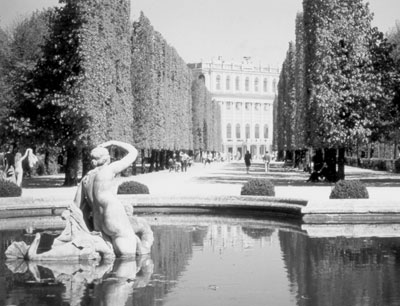All Aboard » Vienna’s new Airport Express
by Jay Brunhouse
After officials finished making speeches and congratulating themselves, on Dec. 14, ’03, the first big, 3-carriage double-decker Vienna Airport Express train took passengers from Vienna’s new City Airport Terminal within Mitte Station in the heart of Austria’s capital city to the International Airport at Schwechat, and it took only 16 minutes.
The owners, the Austrian Federal Railroads (ÖBB; visit www.oebb.at) and Vienna International Airport (www.viennaairport.at), had branded it “City Airport Train” (CAT; www.cityairporttrain.com), applied a green, white and gray livery and hired designers to specially modify the trains with extra-wide, 2+1 seating and luggage racks for half-hourly fast service plus half-hourly stopping service between Schwechat Airport and downtown. Fares are €8 (near $10) one way or €15 round trip. Children ages six to 15 pay €5 and €8, respectively.
You may check in your luggage on the City Airport Terminal’s new platform. Mitte Station is the hub of S-Bahn lines 1, 2, 3 and 15 and U-Bahn lines U1, U3 and U4, so any place in Vienna is easily within your reach. Vienna Mitte has been issued an airport code so that you can ticket your flight right into the center of Vienna.
The project cost €350 million, due in part to the 1.5 miles of tunnel. Between Mitte and the airport you pass through Rennweg Station, which engineers completely rebuilt with a central platform replacing side platforms; all-new Geiselbergstrasse Station, with connections to tram line 6; the rebuilt Zentralfreidhof Station, and Oberlaa.
When you arrive by plane at Schwechat, follow the pictographs illustrating a train to the station below. At the ticket office on the train platform buy single or round-trip tickets for downtown Vienna, validate your European East Pass, Eurail product or Austrian Railpass, or buy a Vienna Card.
ÖBB’s “Vienna Airport Lines” bus services continue to serve Vienna Airport from the West Train Station, with a pickup at the South Train Station, daily between 5:30 a.m. and
12:15 a.m. They take 35 minutes to the airport from the West station.
UNESCO Vienna
Vienna has never been more beautiful. The historic center of Vienna is rich in Baroque ensembles, castles and gardens, as well as grand buildings, monuments and parks lining the late-19th-century Ringstrasse.
The Historic Center of Vienna (www.vienna.info) was inscribed in 2001 as a UNESCO World Heritage Site (www.unesco.org) because it exceptionally well illustrates by its urban and architectural heritage three key periods of European cultural and political development (the Middle Ages, the Baroque period and the Gründerzeit) and because, since the 16th century, Vienna has been universally acknowledged as the musical capital of Europe.
In the Historic Center, you will feel awed by the majesty of the Hofburg, which was the imperial palace and the favorite residence of the Hapsburgs; the Albertina Collections; the Kunsthistoriche Museum (Art History Museum); St. Stephen’s Cathedral in the heart of the city; the Old Quarter, and, of course, the Vienna Opera. Even Otto Wagner’s gilded marble Art Nouveau decoration of Karlsplatz subway station is beautiful.
Vienna gained a major new collection when the Albertina Museum (www.albertina.at), housing the world’s largest collection of graphic art (60,000 drawings and a million prints), reopened on March 14, 2003, as a modern venue for exhibition. Major shows have included Edvard Munch, Albrecht Dürer, Gustav Klimt, Raphael and Picasso. Until Aug. 29, you can see “Pop Art & Minimalism,” including Warhol’s famous “Mao.”
Vienna’s shopping center is near the Hofburg, St. Stephen’s Cathedral and the Opera, which are located along the Kärntnerstrasse, Graben and nearby streets. Shops display the latest fashions, porcelain, crockery, glass jewelry and goldsmiths’ creations, and you pass large bookstores, music shops and, of course, coffeehouses with luscious Torten (fancy cakes).
Schönbrunn
Take an S-Bahn train to the Palace and Gardens of Schönbrunn (www.schoenbrunn.at), a magnificent world of Baroque culture inscribed as a UNESCO World Heritage Site in 1996 — and be sure to note the splendid Art Nouveau Hofpavilon Hietzing, the S-Bahn Station that Otto Wagner created for the exclusive use of Franz Josef I.
Schönbrunn Palace, the number-one tourist attraction in Vienna, is among the most important Baroque structures of its kind in Europe. Conceived and built as a summer residence for the Hapsburgs, from the 18th century to 1918 Schönbrunn was the residence of emperors, and it is full of outstanding examples of decorative art. Together with its gardens, which in 1752 was the site of the world’s first zoo, UNESCO deems it a remarkable Baroque ensemble.
With the 3-day Vienna Card, available for €16.90 ($21) at hotels and at the Tourist Office at Albertinaplatz (open daily 9 a.m. to 7 p.m.) as well as at subway information booths, you can travel free by S- and U-Bahn trains, buses and streetcars, and its 88-page coupon book provides benefits at 180 museums, sights, theaters, concerts, shops, restaurants, cafés and wine taverns and on shuttle buses from the airport.
And while you are in Austria, do not fail to visit other remarkable UNESCO sites, including the Semmering Railroad, which I described in a previous column, the Cultural Center of Graz (Graz was the Cultural Capital of Europe 2003), the Historic Center of Salzburg, the Wachau Cultural Landscape and the Salzkammergut Cultural Landscape.
I thank the Austrian Tourist Office (www.austria-tourism.at) for my hospitality in Vienna, which was arranged through the German National Tourist Office (www.cometogermany.com) and included accommodations at the 1994 four-star Hotel Wimberger (www.arcotel.at), which is only five minutes from the West Train Station. Transportation was by Lufthansa (www.lufthansa.com), which has new connections to Charlotte and Eastern Europe. ITN
Editor’s note: The sixth edition of Brunhouse’s “Traveling the Eurail Express” was published by Pelican in February. It is available from travel and online bookstores.



